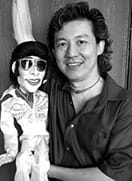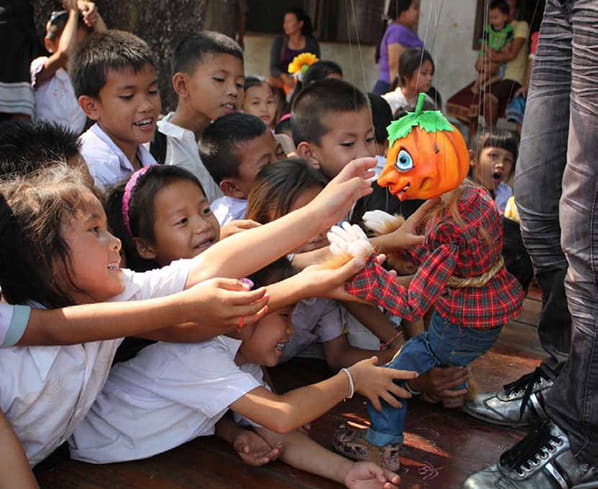Stories > Global Cachet
Global Cachet
Puppetry’s universal appeal crosses cultures and a small vanguard of people is passionate about keeping this ancient art alive.
By Kim Lee with additional reporting by Roslinah Rasdi
Children in Vientiane, Laos, are enthralled by puppets brought to life by Frankie Malachi (right) at the first APEXAsia Puppetry Exchange in April 2012, an initiative to foster artistic exchange and friendship presented in partnership with Artsolute Asia with the support of the Singapore International Foundation. PHOTO: MASCOT AND PUPPET SPECIALISTS
Moving dolls held up by strings, and the stories they tell, hold audiences rapt across cultures. The magic of this traditional art continues to speak to young and old alike, in a language that transcends barriers.
Death and Birth
“Puppetry was quite vibrant here and puppeteers were like superstars until the introduction of movies, TV and computers,” said puppeteer/playwright Benjamin Ho, director of Paper Monkey Theatre (www.papermonkey.com.sg). Since then, he added, “the surviving puppetry troupes in Singapore have lost most of their skills as old masters passed away.” For Tan Beng Tian, artistic director of The Finger Players, the experience of death brings into focus what was being lost. She said, “Back in 1987, I came very close to being an apprentice to the late Master Lee Chye Ee. Master Lee was a migrant from Fujian Province of the People’s Republic China (PRC) and one of the pioneer traditional hand puppeteers in Singapore. In the late ‘80s, it was very tough for him to find apprentices to pass his skills and knowledge to because no one was interested in puppetry. When I was approached, I turned down the offer, thinking that this career would not put bread on my table. I continued in my pursuit of graphic design which seemed more stable as career. Three years later,
I received news of Master Lee’s death in a car accident. With that, his repertoire of traditional hand puppet shows had come to an abrupt end — he had no one to pass them on to. I couldn’t help but feel guilty about this…and pity that his art died with him.
“Fast forward two years. I was disillusioned with graphic design. Images of Master Lee kept recurring. I felt a duty to help him continue his art form. My new aim was to learn traditional hand puppetry to prolong this art form. “I took off for PRC — the origin of traditional hand puppetry, and trained under renowned hand puppeteer Master Li Bofen for one-and-a-half years under a National Arts Council’s Bursary. On returning to Singapore, I co-founded The Finger Players in 1996 under the guidance of Ms Tan Beng Luan and the late (playwright) Mr Kuo Pao Kun.” But Beng Tian found that getting going was tough.
E is for Entertainment
In spite of puppetry’s long legacy and its influence from surrounding countries on Singapore’s cultural consciousness, “No one was familiar with the word ‘puppet’,” said Tan. “People always gave me a blank look when I mentioned ‘puppet’. I had to add, ‘You know, Sesame Street?’ Then the response was, ‘Oh…’ with the nodding of their head.” The magic of Sesame Street’s puppets, or Muppets as Jim Henson’s creations were called, appears to be the stuff of dreams. It started people like Terence Tan of Artsolute and Frankie Malachi, puppeteer, founder and creative director of Mascots and Puppets Specialists (MAPS) imagining lives with puppets.

Frankie Malachi actively promotes his brand of puppetry to a local and international
audience to keep the art form alive. Malachi’s performances have been funded
by Singapore International Foundation’s Singapore Internationale programme.
The Singapore International Foundation has supported MAPS (www.mascotsandpuppets.com) three times to present overseas, once under their own application to Vietnam and Turkey, and once under Artsolute to Vietnam and Laos. The projects by MAPS and Terence, especially their collaborative performances and workshops in Vietnam and Laos, with schools, villages and artists, aimed to foster cross-cultural understanding and more closely knit ties within the greater community. “Young people have many choices for entertainment today: Internet, social media, etc,” said Malachi, of MAPS, an awardwinning puppetry company of international recognition. In spite of an era awash with choices for entertainment, he notes that puppetry is boldly marching into new frontiers. It’s being used in more environments, such as outdoor entertainment, and increasingly, requests are made for puppetry art by the media, government departments and other non-traditional organisations, to reach out to audiences.
“One issue puppet groups face is how to make puppetry relevant and attractive to them,”
he says. Since 2004, Malachi has been showing how it’s being done. MAPS produces and creates puppetry productions and shows, as well as puppets and mascots for projects ranging from theatre productions to stadium events. But why is that, particularly in a place like Singapore with glitzier technology options for information, entertainment and education?
Trumping Technology
“From my perspective,” said Ho, “puppetry has relevance. I always tell people that
puppetry is the ancestor of digital games and animation.”
And puppetry, like any traditional art form, will always trump digital entertainment because it cannot be replicated by technology. According to Tan, “Traditional art forms (such as puppetry, dance or Chinese opera) are mainly about skills and techniques. These cannot be replicated by technology. For example, many years ago, Professor Chen from NTU’s (Nanyang Technological University) animatronics department approached me. Together with his students doing their Masters degree, they wanted to simulate a string puppet in motion using motors and computer programming. The discovery was that there were pros and cons to animatronics.”
A machine-manipulated puppet show could be repeated endlessly in a day. But with puppeteers, only a limited number of shows can be performed daily because humans get tired. However, the human manipulated puppet is livelier and its movements very organic, whereas the puppet manipulated by machine is very controlled and predictable.
Added Tan, “So we still need to go back to the ancient art form, refer to it, learn and understand it, before we can implement new technologies into it.” Another instance of technology needing tradition comes from Malachi. “We were approached by a scientific agency to create a prototype robot that could be used in treating and assessing patients with mental disabilities. They needed someone who could make their robot feel more friendly and approachable to patients. The skills involved in making an inanimate puppet appear ‘real’ and friendly to the audience could be applied in their situation.”

Twisted, a production by The Finger Players that stars Tan Beng Tian (right), its artistic director; Photo Credit: The Finger Players
Old is Gold
“There is value in old practices, and people are beginning to see and appreciate that because the advent and proliferation of technology have only increased our awareness of its limitations,” said Chong of The Finger Players. “While necessary, science and technology are insufficient in helping us live our lives more meaningfully. That is perhaps why people are more willing to turn to history, ancient teachings and old practices such as yoga and natural remedies for answers. Likewise, we turn to the traditional arts as a way of learning from our forefathers.

The late Master Lim who at 82 years (pictured) taught students while seated due to poor health. Photo Credit: The Finger Players
“In the process, we inherit their craft and practices to give us a stronger foundation in our art-making. All new forms and inventions are built on their predecessors — the new is a continuous and unbroken line from the old. “In traditional Chinese hand puppetry for example, puppeteers are not seen. But now our puppeteers are actors who perform alongside the puppets they manipulate in a modern theatre setting. There is now a mix of puppetry styles in any given show, augmented by modern theatre lighting and sound to enhance the theatrical experience.”
Embracing Change
Modern technology aside, puppetry has evolved. From her research in traditional hand puppetry and string puppetry, Beng Tian has discovered that it has been slowly changing for centuries. “An 80-year-old traditional repertoire could have been staged differently 50 years ago. Why? Because the environment changed. For example, the particular type of wood once used for puppet heads had become hard to get or extinct. So new materials have replaced old materials. Old catch phrases have been replaced by new and trendy catch phrases. Generally, such changes or modifications were done naturally — initiated from the artists’ side or the population.”
Singapore’s relatively shorter history than its neighbors can be a strength, according to Chong, because “we are more adaptable and open to changes and influences. While we may borrow from the traditions of our forefathers, we have adapted and made them our own. Puppets designed and made by The Finger Players are a fusion of styles inspired by puppet forms from all parts of the world — East and West and even the Middle East. We are inspired by traditions to form new languages and styles distinct to us. Many have commended our unique theatrical language and style, not seen in other parts of the world.
Our puppetry style and forms may look contemporary but they are actually steeped in traditions and principles of puppetry in construction and manipulation.”
These champions go on despite the usual challenges such as raising sponsorship to keep puppetry alive and growing in Singapore. Because for those who walk this path with their heart, the cause is something larger than themselves. For one, Terence, who organised the ASEAN Puppetry Festival, sees the endeavor of keeping puppetry flourishing as his service to the new generation. “One parent was so thrilled to see his son enjoying himself during a puppet-making workshop that he came and paid me $10 for the material fee. I learnt that he had lost his job and I was really touched by his sincerity. People like that remind me why I am doing what I do.”
The SIF’s Singapore Internationale programme partners Singapore artists as cultural ambassadors engaging in collaborative work with artists overseas. In 2012, it helped to present 108 works by 92 artists in 34 countries.
Puppetry: Origins and Originality
Traditional puppetry in Asia has quite a different character from the Punch and Judy tradition in the West.
“Most of the Asian puppet traditions originated in the epic tales of the Ramayana and the Mahabharata,” said producer and researcher Terence Tan, director of Artsolute (www.artsolute.asia), the man who helmed the ASEAN Puppetry Festival. “Then they each developed organically in their own region,” from complex Japanese Bunraku-style puppetry to Indonesian wayang kulit (shadow puppetry), and traditional Chinese puppet theatre from Taiwan and China. “For example,” he added, “water puppetry in Vietnam developed from the flooding of the delta area for rice cultivation.”
“Many Asian puppetry forms and stories have been informed and influenced by their peoples’ culture and legends,” echoed Chong Tze Chien, company director of The Finger Players (www.fingerplayers.com). “In most of these traditions, art and livelihood are one…and integral to the lives of the people. As such, many of their puppets and stories have a religious and cultural significance that goes beyond mere entertainment. Culture and art are the bloodline of the people, and their puppetry reflects that.”
Such culture and art was reflected in the 2012 ASEAN Puppetry Festival, one of the largest gatherings for the ASEAN Puppetry Association. Ten puppet theatre companies from Malaysia, Indonesia, the Philippines, Vietnam, Thailand, Cambodia, Laos and Singapore participated. It included an exhibition of 100 puppets made by youth from participating Southeast Asian countries, workshops on puppet-making and storytelling for participants of all ages.



